Marc Marquez was naturally asked about his elbow-on-the-pavement riding style in the MotoGP press conferences last weekend at Circuit of The Americas. Who remembers today, but Jean-Phillipe Ruggia first did this on a 250cc GP bike back in 1988. Marquez replied that, “I like the elbow, because when I feel it touch, I go down a bit more.”
In the mid-1950s, John Surtees was criticized by his elders for hanging off the inside of his four-cylinder MV Agusta instead of riding “with the machine.” At the time, he gave a reason, which remains just as true today: “The idea is to keep the machine as upright as possible for maximum traction.”
When you combine such a body-to-the-inside style with the amazing grip of today’s MotoGP-spec Bridgestone tires, there is no longer room under the machine for the classic knee-on-the-pavement position. Instead, you see today’s riders packaging themselves along the bike, looking like a man lying on his side to look under a car. The inside knee is up against the bike, and the elbow is very close to the ground. All this is done to keep from having to lean the machine over any more than absolutely necessary. Today, big lean angle numbers, like 63 to 64 degrees, are common.
Why not lean over more? The very edges of the tires are made of rubber less directly supported by the inflated fabric carcass within. This makes them more flexible. If you have ever ridden a bike with knobby tires on pavement, you have felt it “walk” sideways on the flexing knobs. Something similar happens on the edge of Bridgestones, so to get enough grip to support both cornering and acceleration, the rider tries to hold the bike more upright, using a part of the tread that is directly supported by the carcass.
Many have noted that Marquez’s bike is not leaned over as far as some. The reason is that his body is far off the inside to hold the bike more upright. And when he is ready to accelerate, he pushes the machine more upright very rapidly, putting it “on the carcass” instead of on the very edge.
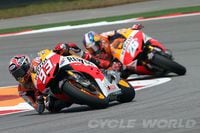
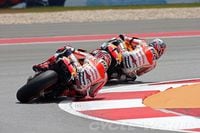
/cloudfront-us-east-1.images.arcpublishing.com/octane/2PLTVHXY7FDSPFHKU5CFOC43ZY.jpg)
/cloudfront-us-east-1.images.arcpublishing.com/octane/B6M3WTRLFZGNXBEATNXPVGBBD4.jpg)
/cloudfront-us-east-1.images.arcpublishing.com/octane/4CMH3FI73BEM5D6MFYX42FLDSQ.jpg)
/cloudfront-us-east-1.images.arcpublishing.com/octane/RIHAPYNWU5H3XAOXNOPRWCBTQA.jpg)
/cloudfront-us-east-1.images.arcpublishing.com/octane/HU4NUBCL3VAFZA75VYRCMAUHVM.jpg)
/cloudfront-us-east-1.images.arcpublishing.com/octane/OB43AZK7TRA6XLZL5WRDVW2TDA.jpg)
/cloudfront-us-east-1.images.arcpublishing.com/octane/5G44Y3FXWNFSTEQKCA355PXOPU.jpg)

/cloudfront-us-east-1.images.arcpublishing.com/octane/XRI4GTLCVBA5NESASCBIR5LYQI.jpg)
/cloudfront-us-east-1.images.arcpublishing.com/octane/EF7566PXARGMBAOMLWTECYL3LE.jpg)
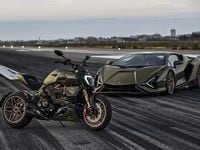
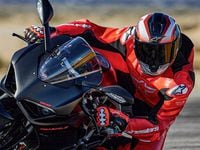

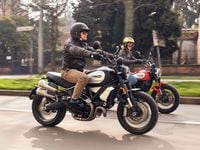

/cloudfront-us-east-1.images.arcpublishing.com/octane/3LASNXSWUZFFPISURDJF3OCWBU.jpg)
/cloudfront-us-east-1.images.arcpublishing.com/octane/2BHJKWUTBNBTLMQCKDNVEG6DKQ.jpg)
/cloudfront-us-east-1.images.arcpublishing.com/octane/MPHXIIV54NAU5L6E4SYZHCXVRM.jpg)



/cloudfront-us-east-1.images.arcpublishing.com/octane/WYXFHF4ZOBBTXELIZDB2FJXU64.jpg)
/cloudfront-us-east-1.images.arcpublishing.com/octane/K5FNV7ONUVDXJJ2H5BIWUGBGTI.jpg)
/cloudfront-us-east-1.images.arcpublishing.com/octane/MGVKP5VTNJHQ7FWNAHIWX4OHO4.jpg)